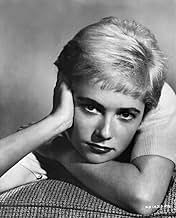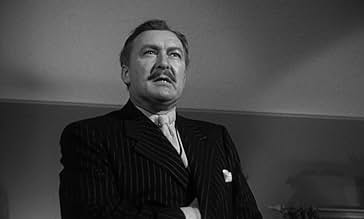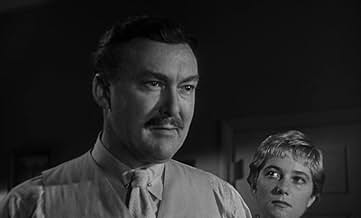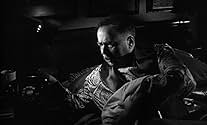AVALIAÇÃO DA IMDb
7,5/10
23 mil
SUA AVALIAÇÃO
Quando uma bela loira é assassinada, um detetive reage de forma violenta. Durante as investigações, descobre uma misteriosa caixa preta que contém a solução do caso.Quando uma bela loira é assassinada, um detetive reage de forma violenta. Durante as investigações, descobre uma misteriosa caixa preta que contém a solução do caso.Quando uma bela loira é assassinada, um detetive reage de forma violenta. Durante as investigações, descobre uma misteriosa caixa preta que contém a solução do caso.
- Direção
- Roteiristas
- Artistas
- Prêmios
- 1 vitória e 1 indicação no total
Marian Carr
- Friday
- (as Marion Carr)
Mady Comfort
- Nightclub Singer
- (as Madi Comfort)
- Direção
- Roteiristas
- Elenco e equipe completos
- Produção, bilheteria e muito mais no IMDbPro
Avaliações em destaque
This late entry into the film noir genre has some harsh and memorable scenes and an ending unlike any other film noir. Of course, most of those weren't made during the A-Bomb scares of the mid 1950s, as this was.
The movie features a tough, no-nonsense Mike Hammer-like private eye, played well by Ralph Meeker, whose tough-guy dialog is a little dated but still fun to hear. This is one of those noirs in which everyone is a tough-talking, tough-acting mug and one never knows who to trust. Except for Cloris Leachman, who is only in the first quick (but haunting) opening scene, the females in here are unfamiliar actresses but people with interesting faces and personalities.
That opening with Leachman is a real attention-grabber and is one of the best starts I've ever seen in a crime movie. It's very creepy, as is the unique ending. I also appreciated the cinematography in here a lot more once the DVD was issued.
The movie features a tough, no-nonsense Mike Hammer-like private eye, played well by Ralph Meeker, whose tough-guy dialog is a little dated but still fun to hear. This is one of those noirs in which everyone is a tough-talking, tough-acting mug and one never knows who to trust. Except for Cloris Leachman, who is only in the first quick (but haunting) opening scene, the females in here are unfamiliar actresses but people with interesting faces and personalities.
That opening with Leachman is a real attention-grabber and is one of the best starts I've ever seen in a crime movie. It's very creepy, as is the unique ending. I also appreciated the cinematography in here a lot more once the DVD was issued.
Man, I saw this movie for the first time a few years ago and I still don't know what to think about it. Ralph Meeker as a fascistic Mike Hammer, a crazy hitch-hiker, an opera fan and a box that can destroy the world. I dunno.
From what I understand Alderitch (the director) hated Mikey Spillane's story (which was about a briefcase full of drugs or money or something else), thought Mike Hammer was an image of brutality and fascism and made a film that reflected it. He makes Hammer out to be some kind of sadist and makes the suitcase out be some kind of nuclear device. The movie turns from a simple detective story to some wierd-ass, sci-fi cold war parable.
It's sort of like the X-Files meets film-noir PI, or something to that effect.
All that being said, this is a GREAT film and is well worth watching by anyone who like apocalyptic film-noir (in fact, this may be the only film in that sub-genre). Anyone who is a fan of bizarre camera work, weird symbolism and a stranger storyline, should really check this out.
Observe the many bizarre inconsistencies (clocks that jump ahead and back, screams that don't jibe right with the soundtrack, camera angles that jump mysteriously) and keep in mind that these were INTENDED! When you get a feel for this film and start noticing what the director was attempting to do with this bizarre film I think that you will enjoy it even more. Truly a unique piece of film making.
From what I understand Alderitch (the director) hated Mikey Spillane's story (which was about a briefcase full of drugs or money or something else), thought Mike Hammer was an image of brutality and fascism and made a film that reflected it. He makes Hammer out to be some kind of sadist and makes the suitcase out be some kind of nuclear device. The movie turns from a simple detective story to some wierd-ass, sci-fi cold war parable.
It's sort of like the X-Files meets film-noir PI, or something to that effect.
All that being said, this is a GREAT film and is well worth watching by anyone who like apocalyptic film-noir (in fact, this may be the only film in that sub-genre). Anyone who is a fan of bizarre camera work, weird symbolism and a stranger storyline, should really check this out.
Observe the many bizarre inconsistencies (clocks that jump ahead and back, screams that don't jibe right with the soundtrack, camera angles that jump mysteriously) and keep in mind that these were INTENDED! When you get a feel for this film and start noticing what the director was attempting to do with this bizarre film I think that you will enjoy it even more. Truly a unique piece of film making.
Robert Aldrich was a no-nonsense film director. When he undertook the direction of this film, little did he know it was going to become the extraordinary movie it turned out to be. The fame seems to have come by its discovery in France, as it usually is the case. Based on Mickey Spillane's novel and adapted by Al Bezzerides, the movie has an unique style and it's recommended viewing for fans of the film noir genre.
Right from the start, the film gets our imagination as we watch a young woman running along a California highway. That sequence proved Mr. Aldrich's ability to convey the idea of a disturbed young woman that seems to have escaped from a mental institution. The plot complicates itself as Hammer learns that Christine, the young woman, has died. He decides to investigate, which is what he does best.
Some excellent comments have been submitted to this forum, so we will not even try to expand in the action but will only emphasize in the tremendous visual style Mr. Aldrich added to the film, which seems to be its main attraction. For a fifty year old film, it still has a crisp look to it thanks to the impressive black and white cinematography of Ernest Lazlo, who had a keen eye to show us Hammer's world as he makes it come alive. The great musical score by Frank DeVol fits perfectly with the atmosphere of the L.A. of the fifties.
Ralph Meeker made an excellent contribution as Mike Hammer. He dominates the film with his presence. Albert Decker, Paul Stewart, Miriam Carr, Maxine Cooper, Fortuno Bonanova, and especially Cloris Leachman, in her screen debut, make this film the favorite it has become.
Fans of the genre can thank Mr. Aldrich for making a film that didn't pretend to be anything, yet has stayed as a favorite all these years.
Right from the start, the film gets our imagination as we watch a young woman running along a California highway. That sequence proved Mr. Aldrich's ability to convey the idea of a disturbed young woman that seems to have escaped from a mental institution. The plot complicates itself as Hammer learns that Christine, the young woman, has died. He decides to investigate, which is what he does best.
Some excellent comments have been submitted to this forum, so we will not even try to expand in the action but will only emphasize in the tremendous visual style Mr. Aldrich added to the film, which seems to be its main attraction. For a fifty year old film, it still has a crisp look to it thanks to the impressive black and white cinematography of Ernest Lazlo, who had a keen eye to show us Hammer's world as he makes it come alive. The great musical score by Frank DeVol fits perfectly with the atmosphere of the L.A. of the fifties.
Ralph Meeker made an excellent contribution as Mike Hammer. He dominates the film with his presence. Albert Decker, Paul Stewart, Miriam Carr, Maxine Cooper, Fortuno Bonanova, and especially Cloris Leachman, in her screen debut, make this film the favorite it has become.
Fans of the genre can thank Mr. Aldrich for making a film that didn't pretend to be anything, yet has stayed as a favorite all these years.
Movies like "Kiss Me Deadly" are reassuring that there's more to each genre than meets the eye. "Kiss Me Deadly" is part hard-boiled detective story & part apocalyptic sci-fi horror film. The movie suspects its own plots and its conventions are ludicrous. The result is a highly inventive film with a ridiculous but highly enjoyable storyline and comically fascinating characters.
The basic plot, loosely adapted from Mickey Spillane's bestselling novel,is: after private-eye Mike Hammer picks up a hitchhiker who is later murdered, he becomes determined to learn the truth about her death. Although the plot becomes more and more insane, it's highly interesting. There are no empty twists, as each one leads to something larger and more confounding.
I've never had more fun with a film noir character than the aptly named character of Mike Hammer. He isn't intimidated by any man and denies the world's hottest women. If he holds the upper hand in a situation, he seems virtually impenetrable. This characteristic leads to the ever-prevalent theme in film noirs of men vs. women and their places in relationships and society.
The film is a masterpiece of cinematography, exhibited in the disorienting camera angles and unique and unconventional compositions of Ernest Laszlo. In fact, Ernesto Laszlo's cinematography is so apt with the film's randomness that it made me giddy.
One of the most distinctive aspects of Kiss Me Deadly is the outrageousness of its final few seconds: the movie doesn't conclude, it detonates. In the hands of the director Robert Aldrich, the film becomes a starting point for a delirious expression of 1950s anxiety and paranoia, starting with opening credits that run backwards and ending with an atomic explosion.
The basic plot, loosely adapted from Mickey Spillane's bestselling novel,is: after private-eye Mike Hammer picks up a hitchhiker who is later murdered, he becomes determined to learn the truth about her death. Although the plot becomes more and more insane, it's highly interesting. There are no empty twists, as each one leads to something larger and more confounding.
I've never had more fun with a film noir character than the aptly named character of Mike Hammer. He isn't intimidated by any man and denies the world's hottest women. If he holds the upper hand in a situation, he seems virtually impenetrable. This characteristic leads to the ever-prevalent theme in film noirs of men vs. women and their places in relationships and society.
The film is a masterpiece of cinematography, exhibited in the disorienting camera angles and unique and unconventional compositions of Ernest Laszlo. In fact, Ernesto Laszlo's cinematography is so apt with the film's randomness that it made me giddy.
One of the most distinctive aspects of Kiss Me Deadly is the outrageousness of its final few seconds: the movie doesn't conclude, it detonates. In the hands of the director Robert Aldrich, the film becomes a starting point for a delirious expression of 1950s anxiety and paranoia, starting with opening credits that run backwards and ending with an atomic explosion.
If The Maltese Falcon (1941) was the definitive true detective movie, The Big Sleep (1946) the definitive glamourized detective movie, and Chinatown (1974) the definitive allegorical detective movie, then Kiss Me Deadly is the definitive sleazy detective movie.
Mickey Spillane's sadistic private eye Mike Hammer, turned from successful private eye to sleazy bedroom dick, is the quintessential anti-hero, doing just about anything and everything wrong to get a piece of the pie that the characters call "The Big What's-it."
The movie survives by giving the usual Spillane buckets-of-blood story and its protagonist new dimensions. Right from the electric opening scene and the audacious opening credit sequence, the audience is drawn into Hammer's seedy world, where morality is suspended, and the credo of the end justifying the means dominates Hammer's actions. His reckless abandonment is almost never questionned and the film seems to understand his brutality as what he must do to get the job done in an equally brutal world.
Director Robert Aldrich observes all of it with an objective eye that neither glorifies nor condemns the action on-screen, letting the audience draw its own conclusions--even where the plot is concerned. The pace is unrelentless and the plot turns are never fully explained, forcing the audience to participate willingly in all that Hammer does to, hopefully, see the story through to its ending.
And what an ending! I'd de damned to a special place in Hell if I elaborated, so I'll just say that it's one of the greatest I've ever seen. That goes same for the movie itself, which is one of the most stylish, jarring and truly entertaining movies of its genre.
Mickey Spillane's sadistic private eye Mike Hammer, turned from successful private eye to sleazy bedroom dick, is the quintessential anti-hero, doing just about anything and everything wrong to get a piece of the pie that the characters call "The Big What's-it."
The movie survives by giving the usual Spillane buckets-of-blood story and its protagonist new dimensions. Right from the electric opening scene and the audacious opening credit sequence, the audience is drawn into Hammer's seedy world, where morality is suspended, and the credo of the end justifying the means dominates Hammer's actions. His reckless abandonment is almost never questionned and the film seems to understand his brutality as what he must do to get the job done in an equally brutal world.
Director Robert Aldrich observes all of it with an objective eye that neither glorifies nor condemns the action on-screen, letting the audience draw its own conclusions--even where the plot is concerned. The pace is unrelentless and the plot turns are never fully explained, forcing the audience to participate willingly in all that Hammer does to, hopefully, see the story through to its ending.
And what an ending! I'd de damned to a special place in Hell if I elaborated, so I'll just say that it's one of the greatest I've ever seen. That goes same for the movie itself, which is one of the most stylish, jarring and truly entertaining movies of its genre.
Você sabia?
- CuriosidadesThe Kefauver Commission, a federal unit dedicated to investigating corrupting influences in the 1950s, singled this out as 1955's number one menace to American youth. Because of this, Robert Aldrich felt compelled to conduct a writing campaign for the free speech rights of independent filmmakers.
- Erros de gravaçãoAt the beginning, Christina (Cloris Leachman) is shown running at the side of the highway, but the shots of only her feet show her running along the painted center line of the highway.
- Citações
Mike Hammer: You're never around when I need you.
Velda: You never need me when I'm around.
- Cenas durante ou pós-créditosThe opening credits scroll down instead of the usual up, resulting in needing to read them bottom to top.
- Versões alternativasUntil 1997, all known copies in circulation of "Kiss Me Deadly" ended rather abruptly: the wounded Mike Hammer stumbling through the beach house looking for his partner Velda, and then there's a couple of brief shots of the house exploding and burning, with "The End" superimposed on the final shot. The music is cut off instead of fading out, and the screen turns black; it looks like Mike and Velda died in the blaze.
- ConexõesEdited into American Cinema: Film Noir (1995)
- Trilhas sonorasRather Have the Blues
Sung by Nat 'King' Cole
Written by Frank De Vol (uncredited)
[Played on the car radio during the opening title card and credits]
Principais escolhas
Faça login para avaliar e ver a lista de recomendações personalizadas
Detalhes
- Data de lançamento
- País de origem
- Idiomas
- Também conhecido como
- El beso mortal
- Locações de filme
- Clay Street, Bunker Hill, Downtown, Los Angeles, Califórnia, EUA(Mike parks his Corvette and takes the back steps up to the Hillcrest Hotel)
- Empresa de produção
- Consulte mais créditos da empresa na IMDbPro
Bilheteria
- Orçamento
- US$ 410.000 (estimativa)
- Faturamento bruto nos EUA e Canadá
- US$ 726.000
- Faturamento bruto mundial
- US$ 952.000
- Tempo de duração1 hora 46 minutos
- Cor
- Proporção
- 1.85 : 1
Contribua para esta página
Sugerir uma alteração ou adicionar conteúdo ausente

Principal brecha
By what name was A Morte num Beijo (1955) officially released in India in English?
Responda




































